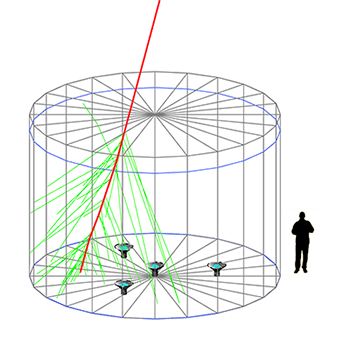UMD Higgs hunters celebrate Nobel Prize in Physics
- Details
- Published: Tuesday, October 08 2013 09:57
 |
| UMD physicists worked on an experiment that led to the Higgs boson and the Nobel Prize in Physics |
The Royal Swedish Academy of Sciences today awarded the Nobel Prize in Physics 2013 to François Englert and Peter Higgs to recognize their work developing the theory of what is now known as the Higgs field, which scientists say gives mass to subatomic and atomic particles, thus making possible the universe and everything in it. The Nobel Committee noted that the ideas of Englert and Higgs “were confirmed by the discovery of a so called Higgs particle at the CERN laboratory outside Geneva in Switzerland.”
University of Maryland scientists played a significant role in the world-wide scientific collaboration that culminated in 2012, when two multi-national research teams generated and detected the long-sought Higgs particle, or Higgs boson, which scientists say confirms the theory of the Higgs field, an invisible energy plane that exists throughout the universe.
“It is fitting that the Nobel Committee has recognized these theorists,” said University of Maryland Physics Professor Nicholas Hadley, chair of the U.S. collaboration board for one of the two experimental teams. “And it is an honor that I and 21 other UMD scientists have been part of the historic international particle accelerator experiments that proved them correct. I congratulate the winners, the particle physics community, and my Maryland colleagues.”
Englert and Higgs and colleagues first proposed the existence of the Higgs field in three scientific papers published in 1964. A key concept held that as particles pass through the Higgs field, they interact with a fundamental particle, the Higgs boson, that endows them with mass. Without mass, particles would not be attracted to one another, and would simply float freely around the universe at light speed.
To test the theory, researchers worked for decades to plan and conduct experiments at the world’s largest particle accelerator, the Large Hadron Collider at CERN near Geneva, Switzerland. On July 4, 2012, members of the two teams, known by the acronyms ATLAS and CMS, announced that they had independently found a subatomic particle that fit the criteria for the Higgs boson.
“Without some kind of Higgs-like field, there really wouldn't be a universe at all,” said Hadley. “Because the particles would have no mass, and if everything were massless, there wouldn't be atoms, there wouldn't be planets, there wouldn't be stars and there wouldn't be people. The great question has been did Higgs, Englert and colleagues get it right with their particular model? And now it appears the answer is yes.”
UMD’s 22 scientists are among nearly 1,300 U.S. researchers from 89 U.S. universities and seven U.S. Department of Energy laboratories who participate in the two ongoing Large Hadron Collider experiments. Maryland’s team helped to build the CMS particle detector and analyzed the masses of data - many times greater than the contents of all the books in the Library of Congress - generated by the experiment, thus helping to confirm the discovery of the Higgs boson particle.
"To find the Higgs boson, we used a collider to smash together protons traveling just a gnat's eyebrow below the speed of light," said UMD Physics Professor and Chair Andrew Baden. "We reconstructed these tremendously high-energy collisions, which recreate the conditions that existed when the universe was about one-billionth of a second old, and tried to find evidence of a new particle, a Higgs boson. And we found it."
The majority of U.S. scientists participating in Large Hadron Collider experiments do so from their home institutions, remotely accessing and analyzing data through high-capacity networks and grid computing. The United States plays an important role in this distributed computing system, providing 23 percent of the computing power for ATLAS and 40 percent for CMS. Maryland’s researchers also helped to build the very high speed electronics transmitting data for CMS.
University of Maryland participants in the CMS experiments included:
Baden, Drew; Bard, Robert; Calvert, Brian; Eno, Sarah Catherine; Ferencek, Dinko; Gomez, Jaime; Grassi, Tullio; Hadley, Nicholas John; Kellogg, Richard G; Kirn, Malina; Kolberg, Ted; Lu, Ying; Marionneau, Matthieu ; Mignerey, Alice; Pedro, Kevin; Peterman, Alison; Rossato, Kenneth; Rumerio, Paolo; Santanastasio, Francesco; Skuja, Andris; Temple, Jeffrey; Tonjes, Marguerite; Tonwar, Suresh C; Toole, Terrence; and Twedt, Elizabeth.




